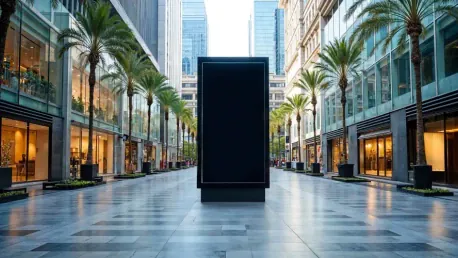The digital out-of-home (DOOH) advertising industry is on the brink of transformative growth, driven by technological advancements and changing consumer behaviors. As we approached 2025, several key trends were poised to redefine the way brands reach their audiences through DOOH media. The increased adoption of programmatic strategies, expansion of inventory across new locations, omnichannel integration, enhanced attribution models, collaborative efforts among media owners, and heightened focus on sustainability are set to shape the future landscape of this dynamic industry.
Programmatic DOOH Adoption
Transition from Experimental to Consistent Use
Over the past few years, programmatic digital out-of-home (pDOOH) advertising has shifted from a novel concept to a critical element of media planning. Brands are increasingly recognizing the benefits of pDOOH and are incorporating it into their long-term marketing strategies. This transition is largely due to the improved accuracy of attribution models, which provide tangible evidence of pDOOH’s effectiveness. Advertisers can now measure the impact of their campaigns with greater precision, leading to more consistent and confident investments in this medium. This shift is indicative of the broader trend toward data-driven advertising, where digital channels provide measurable outcomes that traditional media often struggle to deliver.
Enhancing Campaign Efficiency
The rapid advancement of technology since the advent of pDOOH has significantly optimized campaign efficiency. Programmatic buying allows advertisers to target specific audiences at the right time and place, minimizing wastage and maximizing return on ad spend. By leveraging data from various sources, including location-based insights and consumer behavior patterns, brands can deliver highly personalized content that resonates with their target audience. This level of precision not only improves the effectiveness of campaigns but also enhances the overall consumer experience, making pDOOH a powerful tool in a marketer’s arsenal.
Expansion of DOOH Inventory
Emergence of New Venues
Historically, DOOH advertising has been predominantly associated with high-traffic areas such as malls, airports, and city centers. However, the landscape is rapidly evolving as new venues emerge, offering fresh opportunities for brands to engage with consumers. Fitness centers, padel courts, and even residential buildings are becoming popular locations for DOOH installations. The diversification of inventory means advertisers can now reach audiences in more varied and contextually relevant environments. This expansion is driven by the need to capture consumer attention in places where they spend significant amounts of time, thereby increasing the chances of a lasting impression.
Increased Flexibility for Advertisers
The growing diversity of DOOH inventory also provides advertisers with increased flexibility in their media planning. Unlike traditional static billboards, digital displays can be easily updated and customized to reflect real-time data, seasonal trends, or specific audience segments. This dynamic capability allows brands to stay agile and responsive to changing market conditions. Moreover, the ability to run campaigns across multiple venues seamlessly enhances the reach and frequency of their messages, driving higher engagement and conversion rates. As more locations become equipped with digital signage, the potential for creative and impactful advertising campaigns expands, promising a bright future for DOOH.
Omnichannel Integration
Creating Dual-Screen Experiences
Omnichannel integration is becoming a cornerstone of effective DOOH advertising as brands strive to create cohesive and immersive experiences across multiple platforms. One of the most compelling developments in this space is the creation of dual-screen experiences, where DOOH campaigns are synchronized with mobile and social media interactions. This approach leverages the ubiquity of smartphones and the popularity of social networks to amplify the reach and impact of DOOH messages. By delivering personalized content that aligns with user behavior across different devices, brands can foster deeper connections with their audiences and drive higher levels of engagement and loyalty.
Personalized Creative Content
The trend towards omnichannel integration is also driving the need for more personalized creative content. As consumers become accustomed to tailored experiences in the digital realm, they expect the same level of relevance and personalization in DOOH advertising. Advanced data analytics and artificial intelligence are enabling advertisers to deliver bespoke content that resonates with specific audience segments. Whether it’s a dynamic ad that adapts to the time of day or a message that responds to local events, the possibilities for creative innovation in DOOH are vast. This personalized approach not only enhances the effectiveness of campaigns but also contributes to a more enjoyable and meaningful consumer experience.
Emphasis on Attribution Models
Proving Return on Ad Spend (ROAS)
One of the biggest challenges in the advertising world is proving the return on ad spend (ROAS). In the context of DOOH, this challenge is being addressed through sophisticated attribution models that provide actionable insights into the effectiveness of campaigns. These models track consumer interactions with DOOH ads and measure their influence on subsequent actions, such as website visits, app downloads, or in-store purchases. By linking exposure to tangible outcomes, advertisers can justify their investments in DOOH and make data-driven decisions to optimize their media strategies. This emphasis on attribution is driving greater confidence in DOOH as a viable and valuable advertising channel.
Boosting Marketer Confidence
Improved attribution models are not only providing proof of performance but also boosting marketer confidence in the value of DOOH advertising. As the data becomes more robust and reliable, marketers can better understand the contribution of DOOH to their overall marketing objectives. This increased transparency is fostering a more strategic approach to media planning, where DOOH is integrated with other channels to create cohesive and impactful campaigns. As a result, advertisers are more likely to allocate larger portions of their budgets to DOOH, further fueling its growth and evolution.
Collaborative Efforts Among Media Owners
Unified Networks and Simplified Buying Processes
The DOOH industry is witnessing a shift towards greater collaboration among media owners, who are recognizing the benefits of unified networks and simplified buying processes. By working together, media owners can offer advertisers access to a broader range of inventory through a single platform, streamlining the planning and execution of campaigns. This collaborative approach not only enhances operational efficiency but also increases the reach and scale of DOOH advertising, making it more attractive to large brands and agencies. The trend towards unified networks is paving the way for more integrated and cohesive advertising experiences, which are essential in an increasingly fragmented media landscape.
Enhancing Market Reach
Collaboration among media owners is also enhancing market reach, allowing advertisers to connect with diverse audiences across different regions and environments. By pooling resources and sharing insights, media owners can create more comprehensive and targeted campaigns that resonate with specific consumer segments. This collective effort is driving innovation in the industry, as media owners explore new ways to leverage their combined assets and expertise. The result is a more dynamic and versatile DOOH offering that meets the evolving needs of advertisers and consumers alike, ensuring the continued growth and relevance of the medium.
Sustainability as a Priority
Energy-Efficient Solutions
Sustainability is rapidly emerging as a critical priority in the DOOH industry, with media owners investing in energy-efficient solutions to reduce their environmental impact. In regions like South Africa, there is a growing emphasis on incorporating renewable energy sources, such as solar power, to operate digital displays. Additionally, advancements in LED technology are leading to the development of more energy-efficient screens that consume less power while delivering high-quality visuals. These initiatives are not only addressing environmental concerns but also demonstrating the industry’s commitment to sustainability, which is increasingly important to consumers and advertisers alike.
Adaptability and Innovation
The digital out-of-home (DOOH) advertising industry stands on the cusp of significant growth, driven by advancements in technology and shifting consumer behaviors. As we near 2025, several pivotal trends are expected to revolutionize the way brands engage with their audiences via DOOH media. One major trend is the rising use of programmatic strategies, which allows for more efficient and targeted ad placements. There’s also a notable expansion of inventory in new, diverse locations, making advertising more pervasive. The integration of omnichannel marketing ensures a seamless brand experience across multiple platforms, enhancing consumer engagement. Improved attribution models are giving brands better insights into the effectiveness of their campaigns. Additionally, there’s a growing emphasis on collaboration among media owners, fostering innovation within the industry. Lastly, a stronger focus on sustainability is emerging as a crucial consideration, aligning advertising practices with environmental responsibility. Altogether, these trends are set to reshape the future of this evolving industry.









